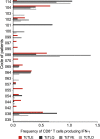Trypanosoma cruzi-specific CD8+ T cells and other immunological hallmarks in chronic Chagas cardiomyopathy: Two decades of research
- PMID: 36683674
- PMCID: PMC9846209
- DOI: 10.3389/fcimb.2022.1075717
Trypanosoma cruzi-specific CD8+ T cells and other immunological hallmarks in chronic Chagas cardiomyopathy: Two decades of research
Abstract
Trypanosoma cruzi, the causal agent of Chagas disease, has coexisted with humans for thousands of years. Therefore, the parasite has developed several mechanisms of antigenic variability that has allowed it to live inside the cells and evade the host immune response. Since T. cruzi displays an intracellular cycle-stage, our research team focused on providing insights into the CD8+ T cells immune response in chronic Chagas cardiomyopathy. We began our work in the 2000s studying parasite antigens that induce natural immune responses such as the KMP11 protein and TcTLE, its N-terminal derived peptide. Different approaches allowed us to reveal TcTLE peptide as a promiscuous CD8+ T cell epitope, able of inducing multifunctional cellular immune responses and eliciting a humoral response capable of decreasing parasite movement and infective capacity. Next, we demonstrated that as the disease progresses, total CD8+ T cells display a dysfunctional state characterized by a prolonged hyper-activation state along with an increase of inhibitory receptors (2B4, CD160, PD-1, TIM-3, CTLA-4) expression, an increase of specific terminal effector T cells (TTE), a decrease of proliferative capacity, a decrease of stem cell memory (TSCM) frequency, and a decrease of CD28 and CD3ζ expression. Thus, parasite-specific CD8+ T cells undergo clonal exhaustion, distinguished by an increase in late-differentiated cells, a mono-functional response, and enhanced expression of inhibitory receptors. Finally, it was found that anti-parasitic treatment induces an improved CD8+ T cell response in asymptomatic individuals, and a mouse animal model led us to establish a correlation between the quality of the CD8+ T cell responses and the outcome of chronic infection. In the future, using OMICs strategies, the identification of the specific cellular signals involved in disease progression will provide an invaluable resource for discovering new biomarkers of progression or new vaccine and immunotherapy strategies. Also, the inclusion of the TcTLE peptide in the rational design of epitope-based vaccines, the development of immunotherapy strategies using TSCM or the blocking of inhibitory receptors, and the use of the CD8+ T cell response quality to follow treatments, immunotherapies or vaccines, all are alternatives than could be explored in the fight against Chagas disease.
Keywords: CD8+ T cell; Chagas cardiomyopathy; Chagas disease; TcTLE peptide; Trypanosoma cruzi; immune response.
Copyright © 2023 Puerta, Cuellar, Lasso, Mateus and Gonzalez.
Conflict of interest statement
The authors declare that the research was conducted in the absence of any commercial or financial relationships that could be construed as a potential conflict of interest. The handling editor declared a past co-authorship with the author CP.
Figures





Similar articles
-
Immunological exhaustion and functional profile of CD8+ T lymphocytes as cellular biomarkers of therapeutic efficacy in chronic Chagas disease patients.Acta Trop. 2020 Feb;202:105242. doi: 10.1016/j.actatropica.2019.105242. Epub 2019 Oct 25. Acta Trop. 2020. PMID: 31669531
-
An Animal Model of Acute and Chronic Chagas Disease With the Reticulotropic Y Strain of Trypanosoma cruzi That Depicts the Multifunctionality and Dysfunctionality of T Cells.Front Immunol. 2019 Apr 26;10:918. doi: 10.3389/fimmu.2019.00918. eCollection 2019. Front Immunol. 2019. PMID: 31105709 Free PMC article.
-
Activation of Human CD11b+ B1 B-Cells by Trypanosoma cruzi-Derived Proteins Is Associated With Protective Immune Response in Human Chagas Disease.Front Immunol. 2019 Jan 4;9:3015. doi: 10.3389/fimmu.2018.03015. eCollection 2018. Front Immunol. 2019. PMID: 30662439 Free PMC article.
-
Understanding CD8+ T Cell Immunity to Trypanosoma cruzi and How to Improve It.Trends Parasitol. 2019 Nov;35(11):899-917. doi: 10.1016/j.pt.2019.08.006. Epub 2019 Oct 10. Trends Parasitol. 2019. PMID: 31607632 Free PMC article. Review.
-
CD8+ T cells in Trypanosoma cruzi infection.Semin Immunopathol. 2015 May;37(3):233-8. doi: 10.1007/s00281-015-0481-9. Epub 2015 Apr 29. Semin Immunopathol. 2015. PMID: 25921214 Free PMC article. Review.
Cited by
-
Genomics in parasitology: Accomplishments and challenges.Biomedica. 2024 Nov 6;44(4):429-433. doi: 10.7705/biomedica.7746. Biomedica. 2024. PMID: 39531544 Free PMC article. English, Spanish. No abstract available.
-
Outcomes of patients in Chagas disease of the central nervous system: a systematic review.Parasitology. 2024 Jan;151(1):15-23. doi: 10.1017/S0031182023001117. Epub 2023 Nov 21. Parasitology. 2024. PMID: 37987164 Free PMC article.
-
Signatures of CD4+ T and B cells are associated with distinct stages of chronic chagasic cardiomyopathy.Front Immunol. 2024 Apr 25;15:1385850. doi: 10.3389/fimmu.2024.1385850. eCollection 2024. Front Immunol. 2024. PMID: 38726014 Free PMC article.
References
-
- (PAHO) (2022) Chagas disease portal. Available at: https://www.paho.org/en/topics/chagas-disease.
-
- Argüello R. J., Vigliano C., Cabeza-Meckert P., Viotti R., Garelli F., Favaloro L. E., et al. . (2014). Presence of antigen-experienced T cells with low grade of differentiation and proliferative potential in chronic chagas disease myocarditis. PloS Negl. Trop. Dis. 8 (8), e2989. doi: 10.1371/journal.pntd.0002989 - DOI - PMC - PubMed
-
- Arias-Murillo Y. R., Castro-Jiménez M. Á., Ríos-Espinosa M. F., López-Rivera J. J., Echeverry-Coral S. J., Martínez-Nieto O. (2010). Analysis of HLA-a, HLA-b, HLA-DRB1 allelic, genotypic, and haplotypic frequencies in Colombian population. J. Colomb. Médica 41 (4), 336–343. doi: 10.25100/cm.v41i4.725 - DOI
-
- Arrunategui A. M., Villegas A., Ocampo L. Á., Rodríguez L. M., Badih A. (2013). Frecuencias alélicas, genotípicas y haplotípicas del sistema HLA clase I y II en donantes de una población del suroccidente colombiano. Acta Médica Colomb. 38 (1), 16–21. doi: 10.36104/amc.2013.69 - DOI
Publication types
MeSH terms
Substances
LinkOut - more resources
Full Text Sources
Research Materials

